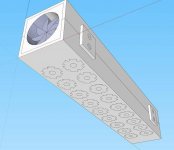Alright, well first let me say hello. This is my first post.
Second, these questions have been asked before, but I want to see what the current consensus on them are.
I want to build a large number of small wattage LED grow lamps. I have determined that the lowest cost per watt is my only real constraint. I decided that I do not care as much about the "quality" of the LEDs, but the "quantity." Everyone has their own opinion of this, but if I can build twice as many units at the same cost, I will recoup the difference in output.
In order to do this I think I want to use 3 colors, which is my current design using 455nm, 620nm, and 660nm lights. Would it be better for me supplementing these 3 waves lengths with Cool White, Neutral White, Orange, UV, etc?
The end objective being cost, I currently believe my best option is to purchase the LEDs in bulk at a low cost. 3W LEDs appear to be the easiest to source in bulk (can be found on ebay), plus are more efficient cost per watt then smaller LEDs. My question is there any benefit to going to larger LEDs when considering their lower cost per watt may be negated by the increased cost in driving the 5 or 10W models?
Those questions aside, I have a basic design already. I am using the cheapest 3W LEDs I can find and an AC input, 60W driver. A simple wind tunnel heat sink and a couple small fans.
Here is my basic design, I would build many of these units:
10 - 3W Red LED 620nm, 2.0-2.5V, .8A, 60-80lm, 120deg
10 - 3W Red LED 650nm, 2.0-2.5V, .8A, 70-80lm, 120deg
6 - 3W Blue LED 455nm, 3.2-3.6V, .75A, 40-50lm, 120deg
1- .68A LED Driver, 60W, AC in 120V
2 - VGA fans, 12VDC, 22.8cfm, 4 cm x 4cm
Very simply, I will make a tunnel out of two pieces of Aluminum channel. I will then mount LEDs on the bottom of the tunnel. A fan on both ends in a push-pull configuration will blow air down the tunnel for cooling.
By my calculations, pushing .68A through the will make 45W. I believe I can make this entire unit for around 30 dollars. Those are real watts, and a price of around 67 cents a watt seems to be beatable only by purchasing made panels from china at high wattage. I should be able to place these throughout my grow instead, mount them in any direction and basically bombard my plants from all angles.
So what do you think?
Thanks ahead of time guys, I have really enjoyed reading your threads and forums.

Second, these questions have been asked before, but I want to see what the current consensus on them are.
I want to build a large number of small wattage LED grow lamps. I have determined that the lowest cost per watt is my only real constraint. I decided that I do not care as much about the "quality" of the LEDs, but the "quantity." Everyone has their own opinion of this, but if I can build twice as many units at the same cost, I will recoup the difference in output.
In order to do this I think I want to use 3 colors, which is my current design using 455nm, 620nm, and 660nm lights. Would it be better for me supplementing these 3 waves lengths with Cool White, Neutral White, Orange, UV, etc?
The end objective being cost, I currently believe my best option is to purchase the LEDs in bulk at a low cost. 3W LEDs appear to be the easiest to source in bulk (can be found on ebay), plus are more efficient cost per watt then smaller LEDs. My question is there any benefit to going to larger LEDs when considering their lower cost per watt may be negated by the increased cost in driving the 5 or 10W models?
Those questions aside, I have a basic design already. I am using the cheapest 3W LEDs I can find and an AC input, 60W driver. A simple wind tunnel heat sink and a couple small fans.
Here is my basic design, I would build many of these units:
10 - 3W Red LED 620nm, 2.0-2.5V, .8A, 60-80lm, 120deg
10 - 3W Red LED 650nm, 2.0-2.5V, .8A, 70-80lm, 120deg
6 - 3W Blue LED 455nm, 3.2-3.6V, .75A, 40-50lm, 120deg
1- .68A LED Driver, 60W, AC in 120V
2 - VGA fans, 12VDC, 22.8cfm, 4 cm x 4cm
Very simply, I will make a tunnel out of two pieces of Aluminum channel. I will then mount LEDs on the bottom of the tunnel. A fan on both ends in a push-pull configuration will blow air down the tunnel for cooling.
By my calculations, pushing .68A through the will make 45W. I believe I can make this entire unit for around 30 dollars. Those are real watts, and a price of around 67 cents a watt seems to be beatable only by purchasing made panels from china at high wattage. I should be able to place these throughout my grow instead, mount them in any direction and basically bombard my plants from all angles.
So what do you think?
Thanks ahead of time guys, I have really enjoyed reading your threads and forums.




